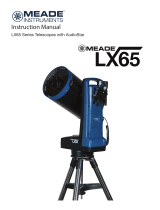Page is loading ...

The LX65 series from Meade Instruments provides amateur
astronomers with (1) a simple-to-use and portable deep sky
visual observation rig and (2) a budget-friendly way to pursue
planetary/lunar astrophotography. While refracting and reflecting
telescopes have obvious advantages, the Maksutov-Cassegrain
(Mak) and Advanced Coma-Free (ACF
™
) telescope designs
provide an extremely manageable size while still offering large
enough apertures and focal lengths to satisfy visual observers
and planetary/lunar imagers.
The whole “manageable size” trait becomes increasingly more
attractive with each use. I have never used an ACF
™
telescope
previously, but I really enjoy the advantages this optical design
offers. Dobsonians clearly have some great advantages over
ACF
™
telescopes, but I really enjoy being able to hold an entire
8” telescope with one hand! But, this is just my opinion.
I purchased the 203mm ACF
™
LX65 telescope with the intent
on it being a dedicated planetary/lunar imaging telescope.
However, the go-to capabilities and advanced electronics make
this thing a breeze to setup and use for deep sky object hunting.
For interested planetary & lunar imagers, the Meade 203mm
LX65 ACF
™
and Meade LPI-G advanced imaging camera
provide roughly a 0.205”/pixel scale at 1x the focal length and
a 0.103”/pixel scale with a 2x barlow (including the additional
focal length provided by the 2” focuser I added). I chose to
add a 2-speed crayford style focuser to enhance the planetary
& lunar imaging experience and I strongly recommend it. The
stock focuser is more than adequate for visual observations.
When my telescope finally arrived, my initial impression was:
“it looks awesome”. I really do like how Meade designed the
LX65 series. From the seemingly durable materials of
construction choices to the color schemes, Meade sure
designed one nice looking telescope & mount combination.
The LX65 mount allows for the addition of a second, smaller
telescope on the other side of the mounting point of the main
OTA. I have experimented with the Meade StarPro 80 telescope
mounted with my 203mm ACF
™
and it really was a lovely night!
I would recommend buying a small, short focal length refractor
telescope if you want to supplement your observations with a
wider field of view.
Honestly, I have used a 42mm eyepiece with the 203mm ACF
™
and found the view to be plenty wide enough for many of the
larger DSOs (M45, M42, and M31). Still, adding a smaller, shorter
focal length refractor (under ~7lbs.) is something to consider.
As far as the mount itself is concerned, the controls are very
intuitive and the alignment process is easy. This is extremely
important, even for experience amateur astronomers. The
AudioStar
®
hand controller is very nice. The handle at the top
of the mount is a convenient trait and I often find myself carrying
the mount this way. I initially attempted to power the mount
through the 12V input with my field battery, but it became
frustrating. Honestly, just use 8 rechargeable C batteries, or
else you will end up wrapping the power cord around the mount
as the telescope spins around! Unless you need 12V accessories
(for example, dew strips), try to stay away from unnecessary
cords and power supplies.
Matthew DeSipio | April 24th, 2019
LX65 203mm (8”) Review

Overall, I really like the appearance and startup to shutdown
operation of my LX65 203mm ACF
™
telescope and mount. The
203mm (8”) ACF
™
is HUGE but still incredibly manageable and
portable. Lunar imaging with this thing is so stress-free, I really
feel relaxed during the image capturing process. Before I show
some images, I want to summarize my LX65 findings:
1. The mount looks great. Handle is a nice feature. Relatively
light. Tripod is easy to disconnect and reconnect quickly.
2. I enjoy the alignment procedure. Align with magnetic
north, level the telescope, and center the alignment stars.
Brilliantly simple.
3. The go-to capabilities and electronics allow for additional
time observing or imaging, and less time hunting. Tracking is
fabulous.
4. The 203mm ACF
™
is huge and looks great. The coma-free
optics are a pleasure, even with wide-field eyepieces
(AFOV>68deg).
5. Use rechargeable C batteries!!! Avoiding unnecessary
wiring cleans up the setup and allows for stress-free operation.
You can barely tell electronics are present and this is very relaxing
under the stars (just like the simple Dobsonian style).
6. Get an aftermarket 2” 2-speed focuser if you are interested
in lunar or planetary imaging. An electronic focuser may be a
nice alternative.
First up, a two-pane mosaic using no Barlow lens (that is,
1x the effective focal length).
Second, let’s try a two-pane mosaic using a Meade 2x Barlow
lens.
You know these are cool. I was very excited and am still
eagerly awaiting better seeing conditions. Finally, let’s look
at a single image using a 2x Barlow lens.
Clearly this telescope can handle some serious magnification.
Focusing was easy with the stable LX65 mount and the
aftermarket 2” 2-speed focuser.
As far as imaging is
concerned, I have only
imaged the moon under poor
seeing conditions so far.
Despite this, the scope and
mount did not disappoint! I
used a Meade LPI-G
advanced camera to capture
the following images. Assume
I stacked roughly 50% of
4000 total frames for all the
of the images.
/

